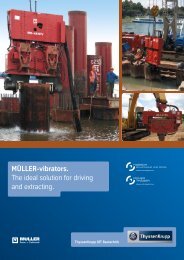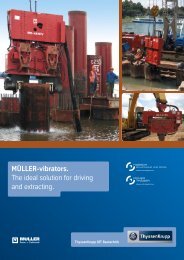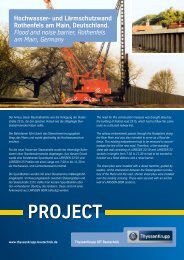NeW THYSSeNKRUPP QUaRTeR NOW OPeN FOR BUSINeSS
NeW THYSSeNKRUPP QUaRTeR NOW OPeN FOR BUSINeSS
NeW THYSSeNKRUPP QUaRTeR NOW OPeN FOR BUSINeSS
You also want an ePaper? Increase the reach of your titles
YUMPU automatically turns print PDFs into web optimized ePapers that Google loves.
14 geRMaNY<br />
NEW INVESTORS<br />
<strong>FOR</strong> OLD<br />
INDUSTRIAL SITES<br />
KeRSDORF LOCK WaS BUILT IN 1891 aND ITS DIMeNSIONS NO<br />
LONgeR CON<strong>FOR</strong>M TO MODeRN ReQUIReMeNTS. PROVIDINg THe<br />
LOCaTIONS aLONg THe SPRee–ODeR WaTeRWaY WITH a PeRMaNeNT<br />
CONNeCTION TO THe TRaNS-eUROPeaN WaTeRWaYS NeTWORK<br />
ReQUIReS aLL THe LOCKS ON THe ODeR–SPRee CaNaL TO Be<br />
ReFURBISHeD SO THaT IN FUTURe THeY CaN aLSO aCCOMMODaTe<br />
MODeRN MOTORISeD CaRgO VeSSeLS UP TO 115 M LONg.<br />
Design<br />
The older, south chamber consists of<br />
gravity chamber walls on a continuous<br />
base, the north chamber of gravity<br />
chamber walls and a chamber base<br />
spanning between these in the form of an<br />
“inverted vault”, in each case made of<br />
concrete. Both head bays are fitted with<br />
gates above a sill. The south chamber<br />
has a lift gate in the tail bay, the north<br />
chamber a mitre gate.<br />
Originally, the lock was operated by<br />
means of side ponds located between<br />
the chambers, but this method of<br />
operation was abandoned for economic<br />
reasons many decades ago. Filling and<br />
emptying are carried out by a siphon<br />
system.<br />
In the light of new settlement successes<br />
brought about by major investments that<br />
are creating hundreds of new jobs, the upgrading<br />
of the Spree–Oder Waterway is becoming<br />
more and more important. “We have<br />
been fighting for these improvements for a<br />
long time. It is therefore very pleasing for the<br />
whole region that refurbishment and expansion<br />
work at Kersdorf Lock has now begun.”<br />
Those are the words of Brandenburg’s<br />
Minister of Transport Jörg Vogelsänger<br />
(SPD), who together with the district administrator<br />
and the mayor in the presence of<br />
members of the federal state parliament,<br />
representatives from the Federal Water &<br />
Shipping Administration, the contractor and<br />
the public gave the signal to start work on<br />
expanding this important and environmentally<br />
friendly form of transport on 26 April<br />
2010. And as appropriate to this project this<br />
was not carried out with an official turning of<br />
the first sod with a spade, but with the first<br />
driving operation. After the VIPs had pressed<br />
the button to start the work, the specialist<br />
crew from Bickhardt Bau AG vibrated the first<br />
sheet pile section, weighing about 3.5 t, into<br />
its vertical position in the ground.<br />
Design und Funktion in idealer Verbindung:<br />
die straßenseitige Außengestaltung<br />
The north chamber of the lock, built in 1904, is<br />
currently being extended from 57 to 115 m with<br />
sheet piling. Some 1900 t of sheet piles, 500 t of<br />
reinforcing steel, 1400 m³ of underwater concrete<br />
and 3000 bonded anchors will be required in the<br />
course of this project. “This lock will be lengthened<br />
to suit the needs of modern shipping,” explains<br />
Thomas Menzel, President of the East Division of<br />
the Federal Water & Shipping Administration. In the<br />
course of this major refurbishment, the crumbling<br />
walls to the lock chambers must also be demolished<br />
and replaced with concrete ones. The lock<br />
gates and their mechanisms will be replaced, and<br />
the control and communications systems brought<br />
up to today’s standards. The upstream basin will be<br />
upgraded to suit the longer lock and will be given a<br />
waiting and coupling point for commercial shipping<br />
plus a separate waiting area for pleasure craft.<br />
All shipping will pass through the south chamber<br />
while the work is in progress - probably a period of<br />
about two years. Once completed, it will be possible<br />
for modern cargo vessels to pass through the lock<br />
without having to be decoupled first and recoupled<br />
afterwards. That will save time and will turn the<br />
Oder–Spree Canal into an attractive mode of transport<br />
for industry once again. Kersdorf Lock is the<br />
westernmost lock for the summit canal of the<br />
Spree–Oder Waterway.<br />
geRMaNY 15<br />
The start of expansion work at Kersdorf<br />
Lock: the first vibratory driving operation<br />
for the first sheet pile section, weighing<br />
about 3.5 t.<br />
Facts & figures<br />
Client/developer<br />
Waterways Building Department, Berlin<br />
Contractor consortium<br />
Bickhardt Bau AG, Kirchheim<br />
Schäfer Bauten GmbH, Ibbenbüren<br />
Materials<br />
approx. 1900 t HOESCH steel sheet pile walls<br />
and steel sheet piles/dolphins, walings, round<br />
steel tie rods, bollards and equipment for steel<br />
hydraulic engineering<br />
Vibratory and driving plant<br />
MÜLLER MS-20 HFV with MÜLLER MS-A 420 V<br />
power pack<br />
MS-32 HFV with MS-A 675 V power pack<br />
MENCK SB 270 fast-action driving hammer<br />
Contact<br />
Dipl.-Ing. Michael E. Bezzo,<br />
Frankfurt am Main Branch<br />
Tel: +49 (0)6028 97911-10<br />
E-mail: michael.e.bezzo@thyssenkrupp.com
















